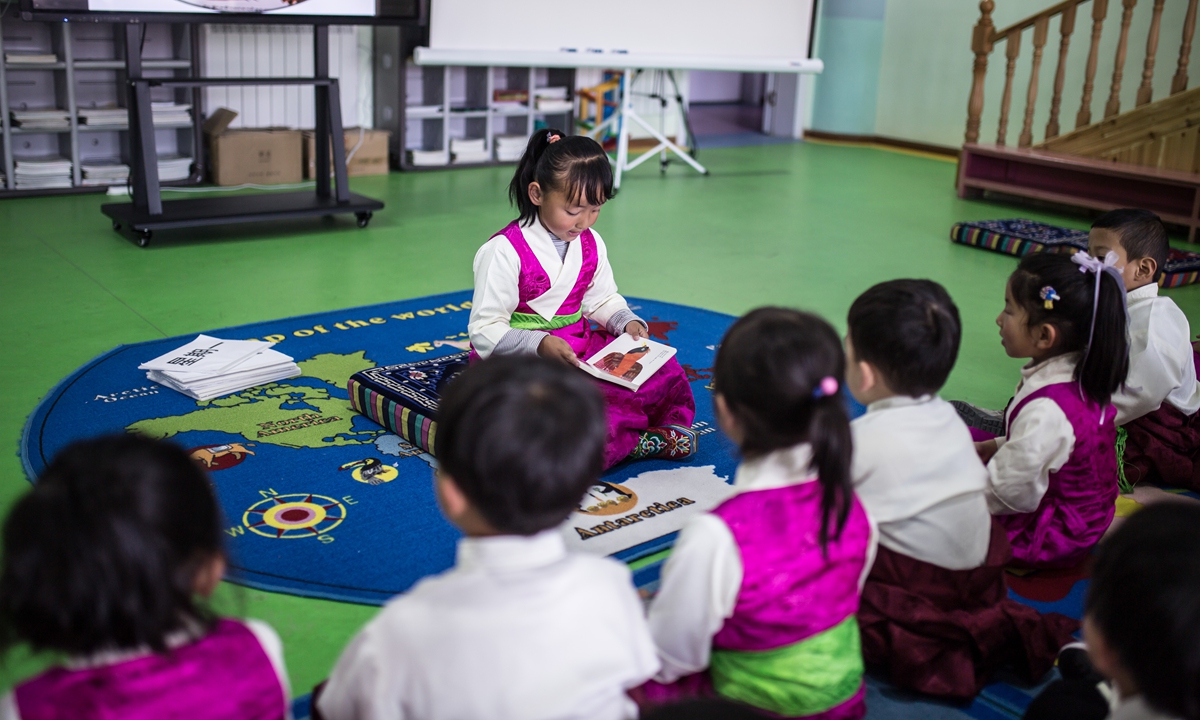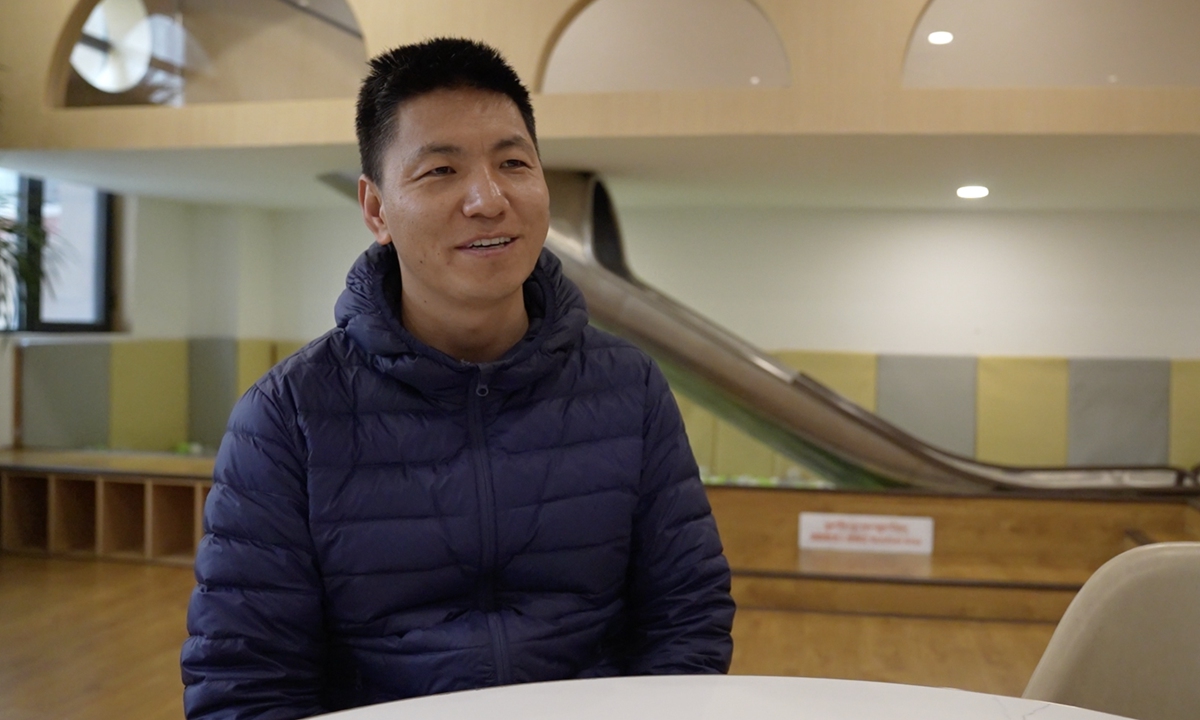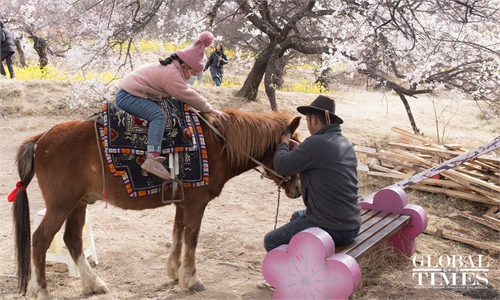ARTS / CULTURE & LEISURE
Publisher in Xizang hopes to pass on traditional culture to local children through picture books
Worth a thousand words

Children read books at the Lhasa Experimental Kindergarten in Lhasa, the Xizang Autonomous Region. Photo: Shan Jie/GT
"Brown Bear, Brown Bear, what do you see? I see a red bird looking at me…"
In a kindergarten in Lhasa, Southwest China's Xizang Autonomous Region, children are reading loudly lines from a classic children's book in the Tibetan language.
The book the teacher presents for them is also with Tibetan sentences.
Tashi Tsering, or Zhaci as he is called in Putonghua (standard Chinese), has made this scene possible.
In the past four years, Tashi Tsering and his team at the Nor Nor Children's Library have published more than a dozen children's books in Tibetan, including Brown Bear, Brown Bear, What Do You See? by US educators Bill Martin Jr and Eric Carle.
Other works include classics such as Guess How Much I Love You and The Very Hungry Caterpillar, as well as My Motherland, All the Way to Lhasa and Wishes of Yaks' Poops, which are closely connected to the lives of children in Xizang.
"I hope through these books we can pass on our traditional culture," Tashi Tsering told the Global Times in a recent interview in Lhasa.
"Also, by reading the books with their parents, they can 'travel' around the country and the world while forming an appreciation for the beauty of art and languages."
Stories of 'nor nor'
"Nor nor" means "precious baby" in Tibetan.
"I hope people can easily remember this name. Also, we hope children can understand parent's love for them," Tashi Tsering said.
The Nor Nor Children's Library was opened in 2020. With a floor area of more than 1,500 square meters, the venue has thousands of the best children's picture books from both China and abroad.
Children's books in Tibetan take up an entire wall.
So far, Nor Nor has published more than 15 books, which have been translated into the Lhasa dialect and printed with great care.
For instance, The Very Hungry Caterpillar is a globally best-selling children's picture book. In order to provide high-quality Tibetan versions for children, Tashi Tsering contacted the author's studio and held multiple negotiations to get the publishing rights to the work.
Finally, the Tibetan language version became the 66th translation of the book.
Tashi Tsering sets the bar high for the Tibetan versions of these books.
"Translation is not actually difficult because children's picture books have minimal text. More effort is required for us to feel the rhythm, pace, and intonation of the text when reading to children," he said.

Tashi Tsering, founder of Nor Nor Children's Library Photo: Li Jieyi/GT
Tashi Tsering is also publishing original works.My First Tibetan Alphabet Book, designed by Tashi Tsering himself, uses the "A for Apple, B for Bear" model to introduce the Tibetan alphabet to young children.
The book became extremely popular after it was released in January 2021. All 4,000 copies sold out within one year.
More and more parents and children in Xizang are hearing about Nor Nor's books.
Copies of the Tibetan version of How the Princess Cleans up Boogers by Chinese illustrator Li Zhuoying, which teaches children about hygiene, were gifted to children who graduated in 2022 from the Lhasa Experimental Kindergarten.
This has been the most fulfilling achievement for Tashi Tsering, as he has gone to great effort to provide more local children with the opportunity to read classic picture books and increase parents' awareness of the importance of early reading, thus spreading the concept of "parent-child reading" to more families in Xizang.
"Nowadays, Tibetan children in Xizang are also exposed to mobile phones and short videos at a very young age. They start speaking Putonghua at a very young age, and we hope to provide them with Tibetan language input through picture books," he added.
In addition to Nor Nor's own published children's books, other Tibetan language children's books from different regions are also displayed here.
Inspiration and practice
Tashi Tsering was born into an ordinary rural family in Gyangze county, Xigaze, Xizang. When he was in primary school, he became interested in illustrated books through a set of blue-covered Tibetan language versions of World's Best Fairy Tales that his uncle had bought.
In 2005, he was admitted to Southwest Jiaotong University in Chengdu, Sichuan Province. After graduation, he stayed in Chengdu and became an English teacher at a training institution.
In 2013, Tashi Tsering returned to Lhasa and co-founded his own training institution. This was also the beginning of his formal contact with illustrated books.
Always interested in preschool education, Tashi Tsering started a podcast on WeChat in 2017 called Nor Nor's Story Time, during which he presented children's audio books in Tibetan, Putonghua and English.
A year later, Tashi Tsering was awarded a scholarship to study abroad in the field of early childhood education. During his one-year study at the University of Pennsylvania, he gained a deeper understanding of children's education and books. He said that he believes the development of children's education in Xizang is relatively late and slow, and most children's books are storybooks, with very few picture books for preschoolers.
On the other hand, the diversity of picture books overall in China is very good, with both foreign imports and local creations.
"In Xizang, more and more people born after 1985 or 1990 are becoming parents. They know about picture books and hope to read them to their children, but they lack a formal platform to get them," Tashi Tsering said.
Leading a team of nearly 20 students from the Han and Tibetan ethnic groups, Tashi Tsering hopes his early childhood education enterprise can continue to develop.
"I also hope that more children and even adults can truly feel the joy that picture books bring," he said.




